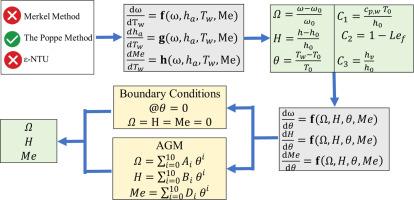用半解析法Poppe法对加湿过程进行热研究
Q1 Chemical Engineering
引用次数: 0
摘要
本研究使用Poppe方法的非线性常微分方程(ode)来评估加湿器中的加湿过程,该方法比传统模型更准确地捕获传热和传质机制。对非线性ode进行了提取、无量纲化处理,并采用半解析方法进行了数值求解。无量纲公式可以详细分析出口空气相对湿度和通过吸收水分增加的空气质量流量。利用半解析方法,分析了提取的无量纲参数对加湿循环性能的影响,并估算了传质系数。半解析法是一种快速、网格无关的分析复杂非线性问题的工具。研究了无量纲参数对湿化性能的影响。结果表明,在较高的盐水温度下,水与空气之间的传热传质增加,导致更高的加湿势。增大与空气焓和质量流量比相关的无因次数或减小与刘易斯因子相关的无因次数均可提高加湿能力。此外,减少与水蒸发相关的无量纲数减少了水蒸发所需的能量,从而增加了加湿潜力。单位面积水流量的增加意味着加湿能力的提高,导致传质系数的增大。在所有测试参数中,质量流量比和与空气焓相关的无因次数增加的传质系数最大,达到最佳条件时传质系数达到9.38×10-4 kg/m2s。本文章由计算机程序翻译,如有差异,请以英文原文为准。

Thermal investigation of humidification process using the Poppe method, a semi-analytical method
This study evaluates the humidification process in a humidifier using the Poppe method’s nonlinear ordinary differential equations (ODEs), which captures heat and mass transfer mechanisms with higher accuracy than conventional models. The nonlinear ODEs are extracted, non-dimensionalized, and solved numerically using the semi-analytical method. The dimensionless formulation enables a detailed analysis of outlet air relative humidity and the increase in the air mass flow rate by absorbing moisture. By use of a semi-analytical method, the influence of extracted dimensionless parameters on the performance of the humidification cycle is shown, and the mass transfer coefficient is estimated. The semi-analytical method is a fast and grid-independent tool for analyzing complex and nonlinear problems.
The effect of dimensionless parameters on the humidification performance are investigated. The results show that at higher saline water temperatures, heat and mass transfer between water and air grows, leading to higher humidification potential. Either increasing dimensionless number related to the air enthalpy and mass flow rate ratio or decreasing dimensionless number related to Lewis factor result in a higher humidification ability. In addition, reducing dimensionless number related to water vaporization decreases the energy required for water evaporation, thereby increasing the humidification potential. An increase in water mass flow per unit area means a higher ability of humidification, causing mass transfer coefficient to grow. Among all tested parameters, mass flow rate ratio and increasing dimensionless number related to the air enthalpy exhibit the highest mass transfer coefficient, which peaks at 9.38×10-4 kg/m2s when optimal conditions are met.
求助全文
通过发布文献求助,成功后即可免费获取论文全文。
去求助
来源期刊

International Journal of Thermofluids
Engineering-Mechanical Engineering
CiteScore
10.10
自引率
0.00%
发文量
111
审稿时长
66 days
 求助内容:
求助内容: 应助结果提醒方式:
应助结果提醒方式:


